Related Research Articles

The Two Towers, both leaning, are symbols of Bologna, Italy, and the most prominent of the Towers of Bologna. They are located at the intersection of the roads that lead to the five gates of the old ring wall. The taller one is called the Asinelli. The smaller tower with a greater lean is called the Garisenda. Their names derive from the families which are traditionally credited with having constructed the towers between 1109 and 1119.

The province of Ferrara is a province in the Italian region of Emilia-Romagna. Its capital is the city of Ferrara. As of May 2023, it has a population of 338,143 inhabitants over an area of 2,635.12 square kilometres (1,017.43 sq mi). The province contains 23 comuni, listed in the list of comuni of the province of Ferrara. Its provincial president is Gianni Michele Padovani.
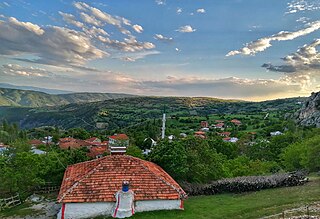
Tokat Province is a province in northern Turkey. Its area is 10,042 km2, and its population is 596,454 (2022). Its adjacent provinces are Amasya to the northwest, Yozgat to the southwest, Sivas to the southeast, and Ordu to the northeast. Its capital is Tokat, which lies inland of the middle Black Sea region, 422 kilometers from Ankara. The governor is Numan Hatipoğlu, appointed in 2022.

The Lahori Gate, also known as Lohari Gate, is one of the 13 gates located within the Walled City of Lahore, Punjab, Pakistan.
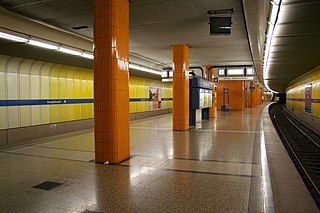
Holzapfelkreuth is an U-Bahn station in Munich on the U6.

The Towers of Bologna are a group of medieval structures in Bologna, Italy. The two most prominent ones remaining, known as the Two Towers, are a landmark of the city.

Palazzo d'Accursio is a palace once formulated to house major administrative offices of the city of Bologna, region of Emilia-Romagna, Italy. It is located on the Piazza Maggiore, and is the city's Town Hall. The palace is also home to the Civic Art Collection, with paintings from the Middle Ages to the 19th century; the Museo Morandi, with the works by Giorgio Morandi; and the Biblioteca Salaborsa, the town libraries.
Dian is a village in the Talin Municipality of the Aragatsotn Province of Armenia.
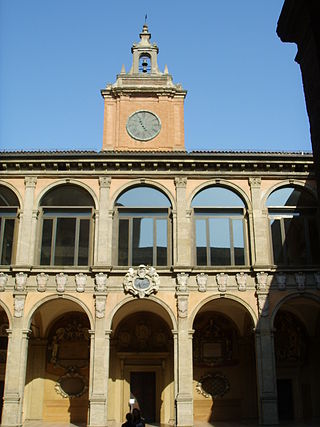
The Archiginnasio of Bologna is one of the most important buildings in the city of Bologna; once the main building of the University of Bologna, it currently houses the Archiginnasio Municipal Library and the Anatomical Theatre.

The Basilica of San Giacomo Maggiore is an historic Roman Catholic church in Bologna, region of Emilia Romagna, Italy, serving a monastery of Augustinian friars. It was built starting in 1267 and houses, among the rest, the Bentivoglio Chapel, featuring numerous Renaissance artworks.

The Porta Saragozza of Bologna was one of the gates or portals in the medieval walls of this city.

The Arco del Meloncello is an 18th-century Rococo structure in Bologna, that forms a pedestrian portico over the road ; it is part of the Portico di San Luca, a long arcade that sheltered the walk from the Cathedral of Bologna to the hillside Sanctuary of San Luca, Bologna. It lies beyond the gates of the Porta Saragozza, outside the former city walls of Bologna.

The Palazzo Pepoli Campogrande, also known as Palazzo Pepoli Nuovo, is a Baroque style palace on Via Castiglione 7 in central Bologna, region of Emilia-Romagna, Italy. In 2015, it served as a public art gallery for late-Baroque art. Across the Via, rises the medieval Palazzo Pepoli Vecchio, also once pertaining to the same family, which now serves as a museum of the history of Bologna.

Porta Maggiore, now known as Porta Mazzini, was the main eastern portal of the former medieval walls of the city of Bologna, Italy. It straddles the site in which the Strada Maggiore of Bologna changes name to via Mazzini, immediately west of the intersection with the Viale di Ciconvallazione.

Porta Castiglione was a portal of the former outer medieval walls of the city of Bologna, Italy.
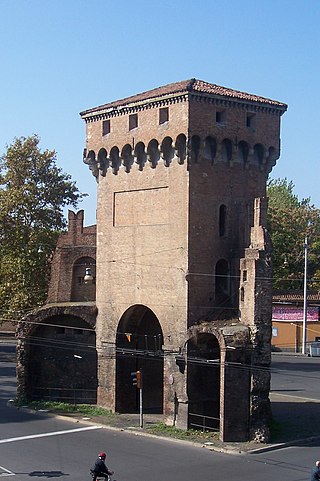
Porta San Felice was the westernmost gate or portal of the former outer medieval walls of the city of Bologna, Italy. It led into Via Emilia, here Via San Felice changes name to Via Aurelio Saffi, After crossing the Viali di Circonvallazione of Bologna.

Porta Galliera was a gate or portal of the former outer medieval walls of the city of Bologna, Italy. It is the most ornamented of all the remaining gates.

Porta delle Lame or Porta Lame was a gate or portal of the former outer medieval walls of the city of Bologna, Italy. It is located at the end of Via Lame, where it meets via Zanardi.
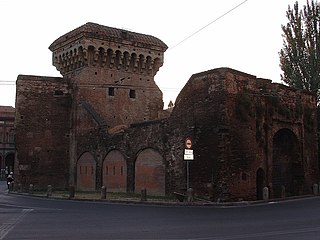
Porta San Donato, also known as Porta Zamboni, was a gate or portal of the former outer medieval walls of the city of Bologna, Italy. It was a gate into the university area of the city.

San Nicolò di San Felice is a deconsecrated Roman Catholic church located on via San Felice 41 in Bologna, region of Emilia Romagna, Italy. Bombardment during World War II caused sufficient damage to close the brick walled structure with a front portico.
References
44°30′08″N11°21′10″E / 44.50222°N 11.35278°E